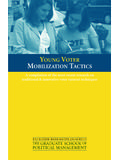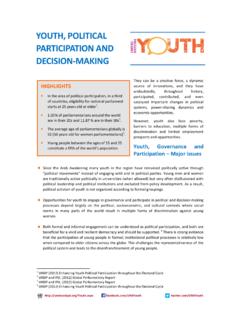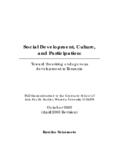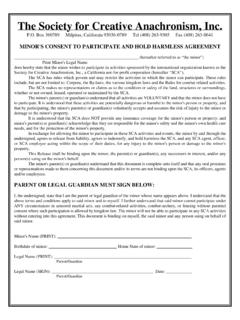Transcription of Understanding a diverse generation - CIRCLE
1 Understanding a diverse generation youth Civic Engagement in the United States November 2011. Kei Kawashima-Ginsberg, CIRCLE Lead Researcher and CIRCLE staff 1. CIRCLE (The Center for Information and Research on Civic Learning and Engagement) conducts research on the civic and political engagement of young Americans. CIRCLE is a nonpartisan, independent, academic research center and was founded in 2001 with a generous gift from the Pew Charitable Trusts. CIRCLE is part of the Jonathan M. Tisch College of Citizenship and Public Service at Tufts University: CIRCLE . Jonathan M. Tisch College of Citizenship and Public Service Lincoln Filene Hall Tufts University Medford, MA 02155. Stay connected Find out about new research by signing up for our monthly e-update: Follow us Facebook Twitter @CivicYouth Understanding a diverse generation youth Civic Engagement in the United States Table of Contents Method 10. Section I. Six Clusters of Young Americans - 2008 12. Political Specialists (2008) 12.
2 Broadly Engaged (2008) 14. Only Voted (2008) 14. Civically Alienated (2008) 15. Engaged Non-Voters (2008) 15. Politically Marginalized (2008) 16. Summary of 2008 Clusters 17. Six Clusters of Young Americans - 2010 18. Civically Alienated (2010) 19. Broadly Engaged (2010) 20. Political Specialists (2010) 20. Under-Mobilized (2010) 21. Talkers (2010) 22. Donors (2010) 22. Section II. How Young People Perform on Specific Civic Indicators 23. Volunteering 23. Community Involvement and Charitable Donations 25. Voting: Presidential Elections 26. Voting: Midterm Elections 27. Voter Registration 28. Political Voice Activities 29. Implications 30. Appendix 32. Technical Notes 37. Endnotes 38. Understanding a diverse generation youth Civic Engagement in the United States figures + tables Figure 1: youth Engagement Clusters, 2008 12. Table 1: Political Engagement and News Consumption Indicators 13. Asked in the CPS in 2008 Only Figure 2: youth Engagement Clusters, 2010 18. Figure 3: National Volunteering Rate by Age, 2002-2010 23.
3 Figure 4: Volunteering Rates among Young People by Race/Ethnicity (2010) 24. Figure 5: Volunteering Rates by Educational Attainment, Ages 18-to-29 24. Figure 6: Community Engagement and Charitable Donation by Age 25. Figure 7: Civic Activities by Race/Ethnicity, Age 18 to 29 26. Figure 8: Voter Turnout by Age in Presidential Elections, 1972-2008 26. Figure 9: Voter Turnout by Age in Midterm Elections, 1974-2010 28. Figure 10: Voter Registration in Presidential Elections 18-29, 1972-2008 28. Figure 11: Voter Registration 18-29 in Midterm Elections, 1974-2010 29. Table 2: Political Voice Activities, by Age 29. Appendix Table 1: Civic Engagement Indicators Included in the 32. Model & Data Source Appendix Table 2: 2008 Clusters Engagement by Indicators 33. Appendix Table 3: Cluster Break-Down By Demographic Groups (2008) 34. Appendix Table 4: 2010 Clusters Engagement by Indicators 35. Appendix Table 5: Cluster Break-Down By Demographic Groups (2010) 36. Understanding a diverse generation youth Civic Engagement in the United States Executive Summary Y.
4 Our analysis shows that outh civic engagement is critical to our democracy. young people should not Young people benefit personally by participating and be treated as a communities need their voices and their energies to address problems. The future of our democracy depends on uniform group. each new generation developing the skills, values and habits of participation. US Census: Current In this report, CIRCLE provides an overview of young Population Survey Americans' civic engagement: their service activities, membership in groups and associations, discussion of Findings presented in this report issues and political participation. Through its annual Current are based on CIRCLE 's analysis Population Survey (CPS), the US Census now provides data of the Census, Current on these and other forms of civic engagement. Focusing on Population Survey (CPS) data. Volunteering estimates are from ages 18-29, we have analyzed this national survey data and the CPS September Volunteering examined the two most recent election years: 2008 and 2010.
5 Supplement (2002-2010) and voting and registration data Our analysis shows that young people should not be treated come from the CPS November as a uniform group. Often called the Millennial generation , . Voting/Registration Supplement, this cohort is extraordinarily heterogeneous. They are the (1972-2010). All other civic most ethnically and racially diverse generation in American engagement indicators, such as access to information and history. Some attend world-class universities while others connection to others, come attend high schools with dropout rates well above fifty from the 2008, 2009 and percent. Thus it is no surprise that they differ greatly in their 2010 CPS Civic Engagement levels and types of civic engagement. Any generalizations Supplements. We used the most about youth voter turnout or young people's volunteering recent data available. However, rates conceal crucial differences within the cohort that some indicators (news access and some political engagement anyone who hopes to engage young Americans should indicators) were only available understand.
6 Some young people will vote in 2012 and some as pooled estimates from 2008- will not. Instead of speculating about what the youth vote . 2009 data. might be, we need to understand the differences among this diverse group so we can work to reduce the number of disengaged youth . Understanding a diverse generation 5 youth Civic Engagement in the United States To explore these differences, CIRCLE conducted a cluster analysis of Census civic engagement data from 2008 and 2010. A statistical technique that divides a sample into distinct profiles, our cluster analysis identified groups of youth with different patterns and levels of civic engagement. Although some similar groups emerged in both 2008 and 2010, our findings from the two years differed in meaningful ways. A majority of the In 2008, the presidential election mobilized millions of young Civically Alienated people to vote and got many talking about political and civic group held a high issues. Three of the six clusters that emerged in our analysis school diploma, only of that year's data reported voter turnout rates at or close 10 percent to 100%.
7 These clusters, Broadly Engaged (19%), Political were Specialists (19%) and Only Voted (18%), differed mainly in whether and how they were engaged beyond voting. The college rest of the youth population clustered into Civically Alienated graduates, (16%), Politically Marginalized (13%) and Engaged Non-Voters and a majority were (14%). While largely comprised of non-voting youth , these people of color. three clusters also differed primarily by their engagement beyond voting. The 2008 clusters clearly reflect the excitement around the 2008 presidential race and overall high levels of civic - especially political - engagement among young Americans. To illustrate how different these clusters were, consider the Broadly Engaged and Civically Alienated clusters. Almost everyone in the Broadly Engaged cluster voted and many also volunteered, worked with youth in their communities, attended public meetings or worked with neighbors to address community problems. Most had at least some college education and were White.
8 Meanwhile, the Civically Alienated group did not vote, volunteer, belong to any groups or otherwise participate in local civil society. A majority held a high school diploma or less, only ten percent were college graduates and a majority were people of color. Understanding a diverse generation 6 youth Civic Engagement in the United States Policymakers and others responsible for civic Talkers 13% education in schools, Under-Mobilized communities Political Specialists and community Broadly Engaged service programs Civically Alienated should focus Donors on the severe gaps in civic The picture shifted in 2010, the most recent year in which participation. political participation was measured. Young Americans fell into different clusters, collectively reflecting a different climate for civic and political engagement than in 2008. We identified a Broadly Engaged cluster (21%) and a Political Specialists cluster (18%) which showed similar patterns of civic engagement to the 2008 clusters with the same labels.
9 While these two groups were about the same size as the equivalent clusters from 2008, the Civically Alienated cluster grew to over one-fifth (23%) of the youth population. Additionally, three new clusters emerged in 2010, Under-Mobilized (14%), Talkers (13%) and Donors (11%). These new groups indicate that a substantial proportion of young people were missing opportunities to engage civically. Under-Mobilized youth were registered to vote but did not cast a ballot, all members of the Talkers cluster reported discussing political issues frequently but did very little else, while Donors gave money to civic or political causes but were not engaged beyond that. Although it is unlikely that 2012 will replicate either 2008 or 2010, our cluster analysis holds important lessons for the future: Reflecting underlying inequalities in social circumstances and opportunity, young people will probably divide into groups ranging from highly alienated to deeply engaged. Policymakers and others responsible for civic education in schools, communities and community service programs should focus on the severe gaps in civic participation.
10 Understanding a diverse generation 7 youth Civic Engagement in the United States Engaging more Engaging more young Americans in civic and political life requires an awareness of how the young adult population young Americans is segmented and the engagement of those subgroups. For in civic and example, the Talkers cluster demonstrated interest in civic and political issues, but many did not vote 2010. Our own political life focus group research has found many disadvantaged young requires an awareness adults fit this profile. Other research suggests that some of how the young adult of these young people could be persuaded to vote if they population is segmented were directly asked to participate or if voting seemed more and the engagement of accessible. Another important group consists of those who those subgroups. voted in 2008 but did virtually nothing else in the civic or political domain. Their interest in the 2008 election could be leveraged to get them involved in other ways. 2008 2010.











